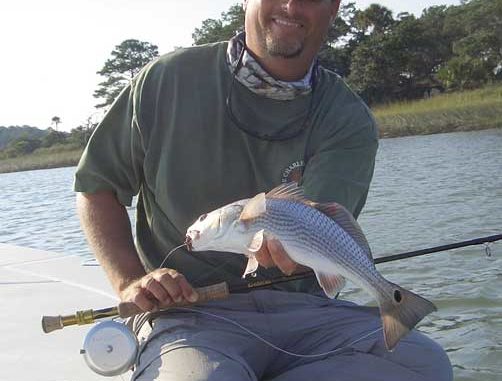
The fall can be a busy time of year for sportsmen in South Carolina, having to balance family gatherings and other pleasurable social commitments.
It’s hard to accept an invitation to go fishing on short notice, but with an invitation to help Captain Bruce Chard, a MASTER Certified Fly Casting Instructor from the Florida keys, find some of our tailing Lowcountry redfish, I felt obliged to lend a hand.
Chard grew up in Vance, Fla., and was raised in the fishing culture that permeates coastal Florida. He packed up and set out to pursue his dreams at 18, moving to the Florida Keys to become a guide. Over the next 14 years, he was able to rise to the top ranks of the small armada of guides that share the flats associated with the Florida keys.
Chard was in Charleston to teach four classes on fly-casting and fly-fishing at the Charleston Angler tackle shop. Teaching fly-casting was really the specialty that led him to a growing notoriety that includes being featured on television shows and gracing the covers of national magazines.
His career has evolved to the point where he is teaching week-long classes every year in the Bahamas and other fly-fishing lodges. He said these lodges “cater to the sportsmen who probably won’t keep their fish. These are the folks that enjoy all aspects of the trip, and they have full-access to me for questions at any time.”
His next class at the Andros bonefishing lodge has a format that includes one day of “school” and five days of fishing the flats, where you can expect to learn a lot very quickly. He goes on to define a fisherman as “a fellow who loves to fish” and a fly-caster as “someone who cares a bit more about what happens after the cast.”
While Chard fishes with all types of anglers, he told me he derives a deep satisfaction out of catching a fish on a fly pattern that he tied himself.
Scores of avid anglers take fly-tying classes because it is a passionate pursuit to master the art of fooling a fish. Did you know that some of the most popular fly patterns are made with feathers or fur from some of our most common gamebirds and animals — like pheasants and whitetail deer? Chard ties several patterns that are marketed for others to try, and they may be purchased from the Riverborn Fly Company.
Our Lowcountry redfish trip out of the Folly River Marina was led by guide John Irwin, who piloted his 19-foot Ranger to a spot behind Kiawah Island. A northeast breeze of 15 miles per hour kicked up, and the water turned murky almost instantly. But it also held the water in the marsh fairly well, and our plan was to ambush the reds right when they were leaving the salt marsh, a spot that Irwin had been “saving” for the right charter.
The experience Irwin has gained in 10 years of guiding had us in the right place, but the weather dictated that we were there at the wrong time. Plenty of salty jokes were passed from bow to stern, and Chard did manage to “dredge up” a couple of reds, but the sight-fishing opportunity we hoped for was “blown out.” Becoming frustrated with fly-casting into the wind, Chard stepped in to explain how to improve.
His demonstrations and his demeanor were on center stage (of the bow) as he made one beautiful cast after another, seemingly without a hint of resistance from the wind. He explained his bullet points and made back-casts accurate to within six inches while simply fooling around, looking natural in the process.
That’s when it dawned on me that Chard was just a natural born teacher, the kind you remember fondly from school, someone who has some good knowledge and wants to share it.
*Your rod tip must travel in a straight path, because the line flows that path. So if you paint the sky with a doughnut motion, you are going to have a fly-line that eventually will tangle and fall at your feet.
* You need an abrupt stop in your motion in both directions. A good rule has always been to move your arm’s position from 1 o’clock to 3 o’clock when fly-casting; this tip tells you to complete that motion perhaps a bit mechanically.
* You need a smooth acceleration of power, or else you get a “tailing loop.” A tailing loop is the ailment that causes your leader to become knotted.
* Stroke length must be equal to the amount of line that you have out. This tip is fairly advanced in my opinion, but practice and visualization can help unlock Chard’s meaning.
* Your pause time must be equal to the amount of line you have out. Once again, this is for me a matter of “feel”, and practice is the only way to help you get to the level of fly-casting that you personally desire.
The five bullet points are what Chard refers to as “substance,” and the actual cast you make after applying all five is more about “style.” An exhibition on style is what I witnessed as Chard executed the “double-haul” — a technique to produce greater line speed, then a snake roll and a spade cast.
With virtually no chance of out-casting either captain, I did take notice of the fact that a flats fishing guide from the Florida Keys, home to bonefish, permit and more, was totally psyched to fish for redfish. The Lowcountry holds its own when it comes to salt-water fishing, and we must respect our estuaries and its inhabitants in order to preserve our unique fishery.



Be the first to comment